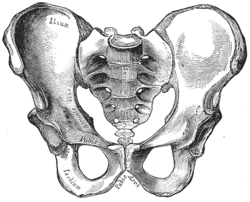Risser sign
| Pelvis | |
|---|---|
 Female type pelvis | |
 Male type pelvis | |
| Anatomical terms of bone |
The Risser sign is an indirect measure of skeletal maturity, whereby the ossification stage of the iliac apophysis is used to judge the ossification of the spinal vertebrae.[1] On a scale of 5, it gives a measure of progression of ossification; the grade of 5 means that skeletal maturity is reached. Risser sign is based on the observation of an X-ray image.
- Grade 1 is given when the ilium (bone) is calcified at a level of 25%; it corresponds to prepuberty or early puberty.
- Grade 2 is given when the ilium (bone) is calcified at a level of 50%; it corresponds to the stage before or during growth spurt.
- Grade 3 is given when the ilium (bone) is calcified at a level of 75%; it corresponds to the slowing of growth.
- Grade 4 is given when the ilium (bone) is calcified at a level of 100%; it corresponds to an almost cessation of growth.
- Grade 5 is given when the ilium (bone) is calcified at a level of 100% and the iliac apophysis is fused to iliac crest; it corresponds to the end of growth.
The Risser sign is referenced in clinical decision-making regarding adolescent idiopathic scoliosis. The earlier the Risser Grade, the greater the likelihood of a scoliosis progressing to the point it becomes clinically significant and requires intervention.[2]
The correlation was first described by Risser in 1958,[3] with a graded classification scheme developed at a later time.
References
- ^ Waldt, Simone; Woertler, Klaus (2014). Measurements and Classifications in Musculoskeletal Radiology. Thieme. pp. 126–127. ISBN 978-3-13-169271-9.
- ^ http://www.aafp.org/afp/2002/0501/p1817.html
- ^ Risser, J. C. (1958-01-01). "The Iliac apophysis; an invaluable sign in the management of scoliosis". Clinical Orthopaedics. 11: 111–119. ISSN 0095-8654. PMID 13561591.
Greulich WW, Pyle SI: Radiographic Atlas of Skeletal Development of the Hand and Wrist, 2nd edition. Stanford, . CA: Stanford University Press, 1959.
